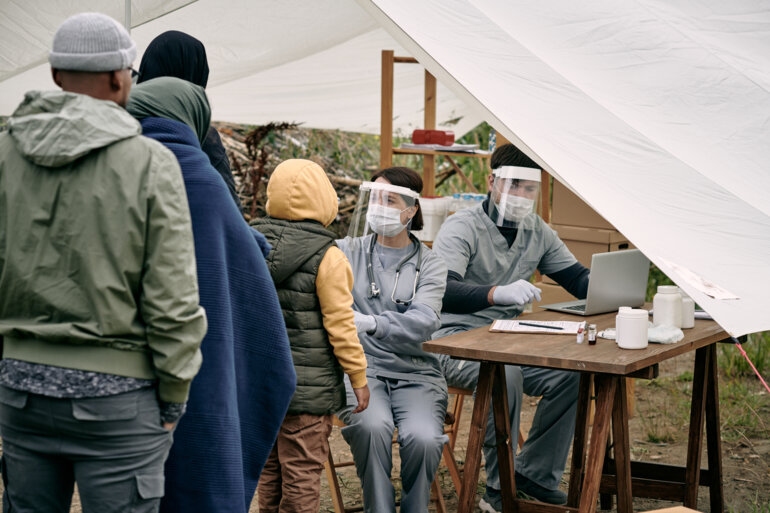The preventive measures currently in place in many countries to limit the spread of Sars-Cov-2 have settled, at least for now, the long-debated question of whether general practitioners (GPs) should partake in the management of cancer patients. If hospital visits are to be reduced to protect potentially high-risk groups from infection with COVID-19, some argue that cancer patient care will likely benefit from being shared with community healthcare professionals going forward.
Dr Massimo Di Maio from Mauriziano Hospital, Turin, Italy, is strongly convinced of the need for better integration between oncology and primary care. He envisions an active role for GPs at every stage of the cancer patient care pathway: “Within the Italian association of medical oncology (AIOM), of which I am the national secretary, we have been advocating for better collaboration with GPs and other community healthcare professionals, because the coronavirus pandemic has exacerbated and made the consequences of their absence plain for us all to see.” These, according to Di Maio, have included dissatisfaction from all sides with the care provided and an overall lower quality of life for patients, when access to hospitals has been restricted and qualified assistance has not been sufficiently available locally.
“Perhaps most worryingly, poor communication between cancer centres and doctors on the territory leads to delays in access to examinations and specialists during the diagnostic phase, potentially affecting patients’ opportunities for early diagnosis,” he adds. How can this connection be strengthened at the very beginning of the care pathway, before a person even becomes a cancer patient?
Direct referral networks can shorten time-to-diagnosis
At Clínico-Malvarrosa Health Department in Valencia, Spain, a cancer fast-track programme (CFP) was launched in 2009, establishing a network between the cancer centre there and 32 primary care centres in the surrounding area. Guidelines were designed for five different tumour types, chosen either because of their high incidence or because of their susceptibility to delayed diagnosis, and communicated to general practitioners to help them identify and refer potential cases to the programme’s oncology coordinator. The coordinator discusses all submitted referrals with a team of six specialists and a primary care physician, and then addresses eligible patients directly to the relevant hospital department for further investigation.
“Before we established he cancer fast-track programme, patients would seek out the opinion of their GP, who would send them on to a specialised centre”
Dr María Teresa Martínez, University of Valencia, Spain, led a 10-year assessment study on the fast-track programme, which has since been implemented at all hospitals of the Comunidad Valenciana region. She explains how the programme changed the diagnostic pathway for patients: “Before we established the CFP, patients would seek out the opinion of their GP, who would send them on to a specialised centre – only there would a specialist assess them and refer them to the hospital. Our programme eliminates this intermediate step.”
Commenting on the findings of the study, which were presented at the ESMO Virtual Congress 2020 (Abstract 1595P), Martínez says: “Through the CFP, the median time interval from a patient’s initial visit to their GP until a confirmed cancer diagnosis was 19 days, and 21 days in cases where cancer was ruled out. Considering that the conventional process can take up to several months, we have managed to reduce the diagnostic waiting time for patients with suspected cancer significantly.”
Out of more than 4,000 suspected cancer cases submitted to the programme over a 10-year period, 1,116 resulted in a positive diagnosis: almost three quarters of these were early-stage cancers for which timely therapeutic interventions were planned. “Going forward, we will need to further examine whether the CFP is truly able to facilitate early-stage diagnosis and determine whether this has a measurable impact on cancer survival,” says Martínez. “In the meantime, it is important to underline the benefits of having been able to provide reassurance more quickly to all the patients who were found not to have cancer.”
Given the high satisfaction levels of both patients and doctors reported in the analysis, the Spanish programme offers a proof of concept that establishing a formal collaboration between primary care physicians and oncologists is not only feasible but also welcomed. And with a goal for the years ahead of having it implemented nationwide, Martínez is convinced that there are no real obstacles to this because results were achieved at no additional cost, simply by optimising existing resources. “That is also why we believe that, economically, this model could work in any healthcare system,” she said.
A facilitated path for cancer survivors
According to Di Maio, improving the currently limited communication between primary care physicians and specialists from the earliest stages of the patient’s journey with cancer is also a prerequisite for providing basic cancer care outside of the hospital. “As soon as active treatment begins, we as oncologists should contact the GP to inform them about its aim and expected toxicities, as well as about the expected evolution of the clinical situation,” he says. “Whenever the patient has an emergency like acute symptoms or severe side-effects at some point of the disease trajectory, he or she has no other option rather than referring to the oncologist for lack of a better way to manage the situation – but in fact, we often experience that many of these cases could be handled locally without hospitalisation if adequate help was available via the GP.”
“In case of acute symptoms or severe side-effects, the patient has no other option rather than referring to the oncologist for lack of a better way to manage the situation”
During the critical phase of the COVID-19 emergency in Italy earlier this year, efforts were even made to transfer some active treatment from hospitals to the community setting. “Oral therapies are well suited for this because patients come to the hospital only to receive a physical exam and be given the medicine – both of which could be managed by the primary care doctor,” Di Maio explains. Although he deems it unlikely that this approach will be generalised for intravenous therapies in the short term, he believes the recent cases in which dedicated physicians and nurses administered these treatments to patients at home proved that individualised approaches are possible.
If a reinforced oncologist-GP collaboration promises to simplify the disease management for patients under active treatment, cancer survivors are those who can benefit the most. “Here, too, we know that after a certain time has passed, it is important that these subjects are no longer managed in the hospital, but by their community GP – that they are no longer treated like active cancer patients, but rather as survivors who can return to normal living.” For these transitions to be smooth, however, patients must feel confident that collaboration between their GP and the oncologist guarantees the quality of the follow-up.
Training GPs in essential cancer care
So why has medical practice lagged behind a changing reality, despite strong new incentives to minimise the time cancer patients spend in hospital? Di Maio’s answer is simple: “Resources. Oncologist-GP cooperation requires well-functioning networks, and for these we need resources – primarily human resources, both on the side of the hospital and on the territory – to ensure the availability and quality of assistance.”
Cancer care is a complex business, so in addition to good communication, reinforcing training opportunities for healthcare professionals would turn into improvements in assisting cancer patients. “One option, proposed by Italy’s AIOM, would be to improve the cancer expertise in the community setting, for instance in the form of territorial doctors specialised in oncology,” continues Di Maio who also envisages a model where all family doctors receive some intermediate training in the management of cancer patients. “Of course, much depends on the means available for this type of initiative in a given healthcare system, but I firmly believe that this is the way we should move forward to make cancer care more sustainable,” he concludes. “Just consider how many of these doctors’ patients will develop some form of cancer during their lifetime: of course, it would be cost-effective to invest in increasing not only their interactions with the specialists, but also their literacy in cancer care.”







